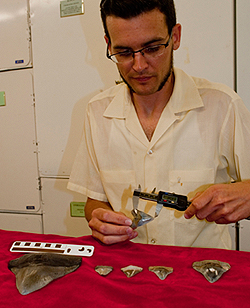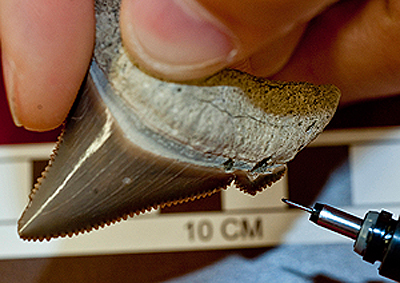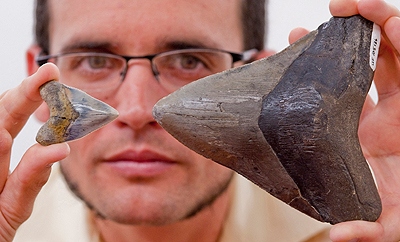Florida Museum of Natural History researchers have discovered a 10-million-year-old Neotropical nursery area for the extinct megalodon shark in Panama, providing fossil evidence the fish used these types of areas to protect their young for millions of years. The article, which appeared in the journal PLoS ONE on May 10, 2010, is the first thorough study of megalodon juveniles and gives scientists a better picture of the shark’s behavior.
“The study provides evidence of megalodon behavior in the fossil record,” said lead author Catalina Pimiento, who recently completed a master’s degree in zoology from the University of Florida and worked in the Florida Museum’s vertebrate paleontology division. “Behavior doesn’t fossilize, but we were able to interpret ancient protection strategies used by extinct sharks based on the fossil record.”
Florida Museum vertebrate paleontology graduate student Dana Ehret was second author on the study, funded by the National Science Foundation.

Florida Museum photo by Jeff Gage
“This study of the megalodon teeth from Panama and its paleobiologic implications demonstrates the potential information that other fossil shark faunas can give us, including survival strategies, feeding habits and life histories,” Ehret said.
Research methods
UF scientists and the Panama Canal Project Field Team from the Smithsonian Tropical Research Institute collected 400 fossil shark teeth between 2007 and 2009 from the shallow marine Gatun Formation, which connected the Pacific Ocean and the Caribbean Sea during the late Miocene Epoch in Panama. Most of the 28 Carcharocles megalodon specimens were surprisingly small, Pimiento said, and analysis determined the size did not relate to tooth position in the jaw or the size of the species during the late Miocene.
The researchers first compared the Panama Gatun Formation teeth to tooth sets from older and younger formations in the United States to determine megalodon shark sizes from different time periods. This was done to rule out the possibility of a change in overall body size of the species through time. The scientists then compared the teeth to other adult and juvenile specimens to determine their life stage. Finally, calculations of the ratio of white shark tooth height to overall body length were used to estimate the size of the megalodon specimens.

Florida Museum photo by Jeff Gage
“Our study suggests the specimens represent mostly juveniles with lengths between 2 and 10.5 meters,” Pimiento said.
Michael Gottfried, associate professor and curator of vertebrate paleontology at Michigan State University Museum, helped review the PLoS ONE article. His method of determining the skeletal anatomy of megalodon sharks based on comparisons with the great white shark was used in this study. Though Gottfried said he did not completely agree with all of the study’s conclusions, he believes the findings are interesting.
“Shark nursery areas are very poorly known, both for living and fossil species,” Gottfried said. “If the teeth from Panama described by Catalina and her collaborators do indeed come from a nursery area for the giant megalodon shark, they have the potential to provide a lot of interesting information on the paleobiology of this enormous, but still very enigmatic, fossil species.”
Would the largest shark that ever lived need a nursery area?
Nursery areas for sharks have ample food resources and serve as protection for juveniles and neonates from predators. Some scientists argue megalodon did not need nursery areas to protect their young because it was the largest shark that ever lived. But researchers discovered teeth in the study area from juvenile megalodon sharks as small as 2 meters long as well as fossil teeth of potential predators like adult megalodons, great hammerhead sharks and extinct snaggletooth sharks. Studies of present-day large sharks such as the tiger shark, great hammerhead and the white shark confirm their use of nursery areas.

Florida Museum photo by Jeff Gage
White sharks, which belong to the same order as megalodon, seasonally return to the eastern Pacific and other coastal “hot spots” for feeding, foraging and mating. The researchers considered the hypothesis that megalodon sharks used the grounds for feeding and reproduction rather than as a protective nursery area, but rejected the possibility based on the high number of juveniles, presence of neonates, shallow water depth of the area and the scarcity of large mammals.
Are there other fossil shark nursery areas?
Previously suggested fossil shark paleo-nursery areas, the Paleocene Williamsburg Formation and late Oligocene Chandler Bridge Formation of South Carolina, were based only on the anecdotal presence of juvenile teeth accompanied by marine mammals.
“Neither of the collections from previously suggested nursery grounds has been as rigorously analyzed as the specimens in this study, which better supports the presence of this paleo-nursery area,” Pimiento said.
Where to find more information
The teeth from the study are now located in the Smithsonian Tropical Research Institute and the Florida Museum of Natural History. The Florida Museum also houses the Florida Program for Shark Research and International Shark Attack File, and it created the traveling exhibit Megalodon: Largest Shark that Ever Lived. For more information on the study, read the official press release or published article.
Other study authors are Bruce MacFadden, Florida Museum of Natural History vertebrate paleontology curator, and Gordon Hubbell of Jaws International.